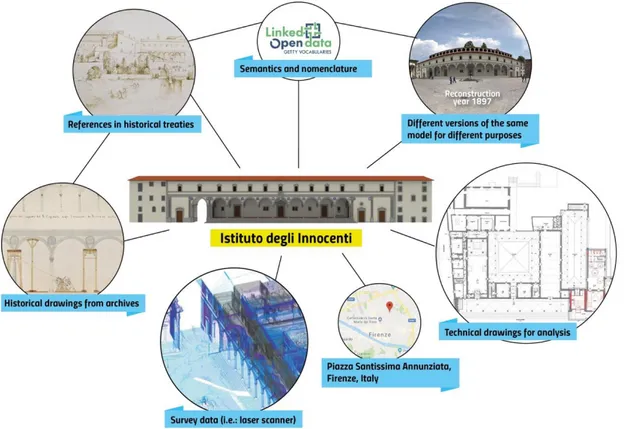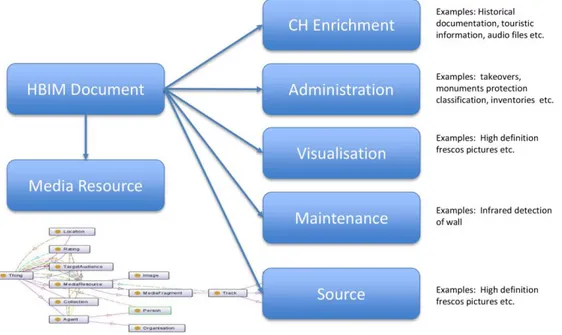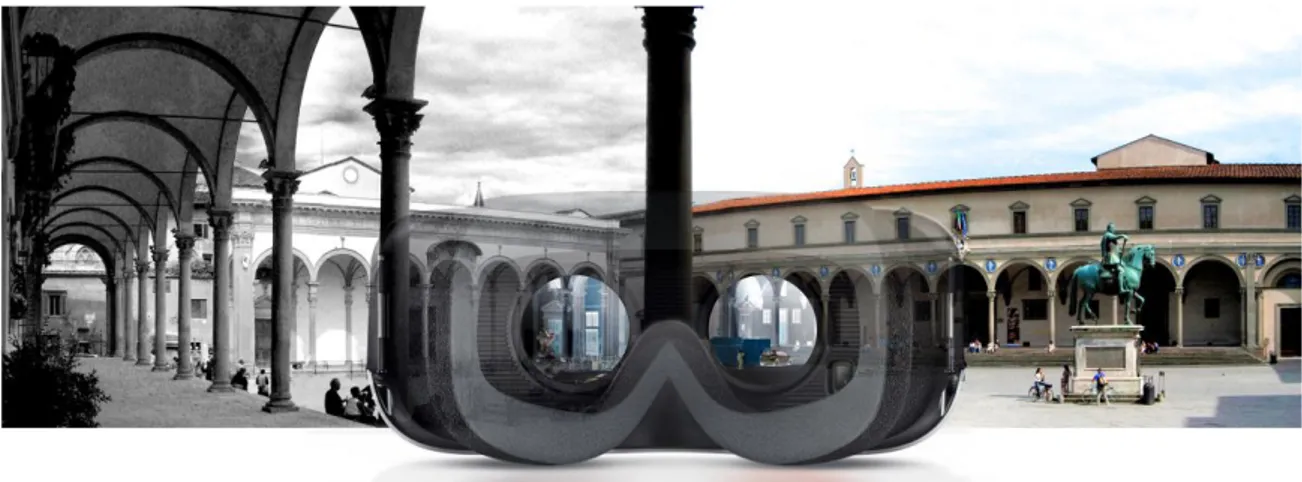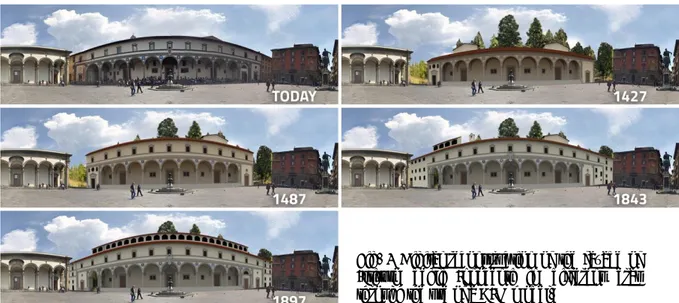IOP Conference Series: Materials Science and Engineering
PAPER • OPEN ACCESS
Enhancing Heritage fruition through 3D semantic
modelling and digital tools: the INCEPTION project
To cite this article: Federica Maietti et al 2018 IOP Conf. Ser.: Mater. Sci. Eng. 364 012089View the article online for updates and enhancements.
Related content
Necessity of creating digital tools to ensure efficiency of technical means
V I Rakov and O V Zakharova
-Digital tool for detecting diabetic retinopathy in retinography image using gabor transform
Y Morales, R Nuñez, J Suarez et al.
-ICT as a tool to foster inclusion: Interactive maps to access cultural heritage sites
Sebastiano Marconcini
1234567890‘’“”
Florence Heri-Tech – The Future of Heritage Science and Technologies IOP Publishing
IOP Conf. Series: Materials Science and Engineering 364 (2018) 012089 doi:10.1088/1757-899X/364/1/012089
Enhancing Heritage fruition through 3D semantic modelling
and digital tools: the INCEPTION project
Federica Maietti, Roberto Di Giulio, Emanuele Piaia, Marco Medici, Federico Ferrari
Department of Architecture, University of Ferrara, via Ghiara 36, 44121, Ferrara, Italy [email protected]
Abstract. The INCEPTION project, “Inclusive Cultural Heritage in Europe through 3D
Semantic Modelling”, started in June 2015 and lasting four years, aims at developing advanced 3D modelling for accessing and understanding European cultural assets. One of the main challenges of the project is to close the gap between effective user experiences of Cultural Heritage via digital tools and representations, and the enrichment of the scientific knowledge. Within this framework, the INCEPTION project goals are consistently aligned while accomplishing the main objectives of accessing, understanding and strengthening European cultural heritage by means of enriched 3D models. At the end of the third year of activity, the project is now facing different challenging actions starting from already developed advancement in 3D data capturing and holistic digital documentation, under interdisciplinary and cross-cutting fields of knowledge. In this direction, the approach and the methodology for semantic organization and data management toward H-BIM modelling will be presented, as well as a preliminary nomenclature for semantic enrichment of heritage 3D models. According to the overall INCEPTION workflow, the H-BIM modelling procedure starts with documenting user needs, including experts and non-experts. The identification of the Cultural Heritage buildings semantic ontology and data structure for information catalogue will allow the integration of semantic attributes with hierarchically and mutually aggregated 3D digital geometric models for management of heritage information.
1. Introduction and overall framework
At the end of the third year of activity, the project "INCEPTION - Inclusive Cultural Heritage in Europe through 3D Semantic Modelling", funded by EC within the Programme Horizon 2020, is facing different challenging actions aimed at models deployment and widespread sharing, starting from a methodological and technical advancement in 3D data capturing and holistic digital documentation.
As part of 3D integrated survey applied to Cultural Heritage, digital documentation is gradually emerging as effective support of many different information in addition to the shape, morphology and dimensional data [1]. The implementation of data collection processes and the development of semantically enriched 3D models is an effective way to enhance the dialogue between ICT technologies, different Cultural Heritage experts, users and different disciplines, both social and technical. The possibility to achieve interoperable models able to enrich the interdisciplinary knowledge of European cultural identity is one of the main outcomes of INCEPTION.
The enhancement of digital cultural heritage accessibility is the ability to access cultural contents and resources for as many people as possible by using ICT functionalities and applications (web sites,
2
1234567890‘’“”
Florence Heri-Tech – The Future of Heritage Science and Technologies IOP Publishing
IOP Conf. Series: Materials Science and Engineering 364 (2018) 012089 doi:10.1088/1757-899X/364/1/012089
data-bases, digital libraries, virtual applications, etc.) overcoming cultural, environmental and management barriers for an easy and spread fruition. Nowadays it is possible to integrate different information in order to access cultural assets in many different ways and for many different purposes, thanks to new languages of interactive media aimed at innovative ways of communication of cultural heritage.
The overall project workflow is developed starting from requirements (what kind of data, information and visualization issues can be collected and managed by a 3D model according to specific users and needs), the integrated data capturing and holistic heritage documentation, the semantic enrichment via 3D modelling in H-BIM environment, and the models deployment and valorization through the INCEPTION platform.
This paper will shortly summarize the INCEPTION approach to the semantic modelling, focusing on heritage buildings and sites. Semantic modelling for Cultural Heritage buildings in H-BIM environment and the development of the INCEPTION platform for deployment and valorization of enriched 3D models will allow accomplishing the main objectives of accessing, understanding and strengthening European Cultural Heritage. In this direction, the approach and the methodology for semantic organization and data management toward H-BIM modelling will be presented, as well as a preliminary nomenclature for semantic enrichment of heritage 3D models. According to the overall INCEPTION workflow, the H-BIM modelling procedure starts with documenting user needs, including experts and non-experts. The identification of the Cultural Heritage buildings semantic ontology and data structure for information catalogue will allow the integration of semantic attributes with hierarchically and mutually aggregated 3D digital geometric models for management of heritage information.
2. Holistic digital documentation
Integrated digital documentation under INCEPTION is carried out through a holistic approach. According to “Principles for the recording of monuments, groups of buildings and sites” (ICOMOS 1996) holistic documentation needs to cover assets of critical information regarding a monument’s main attributes and characteristics, able to define it as a whole and to identify its significance and main needs.
Beyond technical definitions and in-depth specifications regarding measuring instruments and data capturing devices, it has been essential to frame the workflow within the specific field of Cultural Heritage and within the overall concept of heritage documentation.
An interdisciplinary study of a monument leads to the creation of an enhanced methodology approach for the documentation. The overall approach tends to comprise of the documentation, analysis and management of all the different data, visualization, protection and preservation issues. An interdisciplinary process is required for the representation of the shape, the construction materials and the conservation condition. Complete recording addresses not only to the problem of 3D digitization of a monument but involves all the aspects of digital content management, representation and reproduction. Through the 3D digitization of a monument, various aspects of recording concerning diagnostics (building material and decay patterns), construction durability and architectural documentation, new digital content management may be achieved. In this context, interdisciplinary approach means that the advantages and the output of every method applied to a monument, can lead to the 3D modelling approach, improving an inclusive understanding of European cultural identity and diversity.
This is the main direction toward INCEPTION is moving: setting up a methodology able to break through the barriers caused by segmentation in collecting documentation data by establishing a common framework through 3D documentation of Cultural Heritage buildings and sites.
From one side, applications under development allow accessing digital information both from the heritage sites (via mobile devices) and off-site (offices, research labs, museums, etc.) in order to improve access and knowledge possibilities, thanks to interactive experiences and improved digital contents. On the other hand, enriched 3D digital models available in an open-standard format can be
1234567890‘’“”
Florence Heri-Tech – The Future of Heritage Science and Technologies IOP Publishing
IOP Conf. Series: Materials Science and Engineering 364 (2018) 012089 doi:10.1088/1757-899X/364/1/012089
easily accessible and reusable by researchers, scientists, experts, curators, and professionals in different cultural heritage fields, facilitating cross-disciplinary researches, dissemination, education and business opportunities.
2.1. Retrieving and aggregating data
Semantic 3D reconstruction of heritage buildings and sites supposes an interdisciplinary approach based on the collaboration of various experts from different disciplines towards the development of 3D models integrating semantic data. If 3D data can be captured following a more commonly shared procedure (set up, within INCEPTION, by the Data Acquisition Protocol), terminology and interpretation have a large diversity and variability when looking at semantics, due to different competencies, skills and languages.
Making data aggregable asks for a Semantic Web structure in order to give back to different users a new way to look at the information in a Cultural Heritage context. A semantic web structure means also that the relations, properties and composition of the “nodes” of the information give a new insight different from a list of the same concepts or a database structure. Since now, consistent structured data are missing in for Cultural Heritage architectures.
Fig. 1 Schema of the INCEPTION methodology, based on the example of Istituto degli Innocenti by Brunelleschi: from the holistic documentation and data capturing up to semantically enriched 3D models. 3. H-BIM modelling and semantic enrichment
One of the main challenges in 3D modelling is related to an effective BIM approach for cultural heritage knowledge, semantic enrichment and model management. Starting from an improved procedure of 3D data capturing [2] and documentation, INCEPTION proposes an improvement in this methodology by recognizing that buildings are a set of elements named by an architectural style nomenclature and organized by spatial relationships. At the moment, a shared library for historical elements does not exist. Starting from the Heritage Building Information Modelling (H-BIM)
4
1234567890‘’“”
Florence Heri-Tech – The Future of Heritage Science and Technologies IOP Publishing
IOP Conf. Series: Materials Science and Engineering 364 (2018) 012089 doi:10.1088/1757-899X/364/1/012089
approach the necessity of the libraries’ implementation is under development within INCEPTION by avoiding the oversimplification of the shapes. When used in models of Cultural Heritage, semantic BIM [3] will be able to connect different users (e.g. scholars, technicians, citizens, governments), supporting the need for interpretation of the Cultural Heritage model, in addition to the common BIM features of 3D visualization, technical specification and dataset [4].
3.1. The INCEPTION approach
Starting from a definition of concepts and their relationship, the first step in creating semantic BIM for cultural heritage is defining the ontology: a formal representation of knowledge as a hierarchy of concepts within the cultural heritage domain. The linguistic definitions related to the ontology concepts can also be used as shared vocabulary to denote the types, properties and interrelationships of cultural heritage aspects [5].
Naming each architectural element that composes a building is not an easy task. In the field of classical architecture, it is possible to check several books that deeply analyse and summarize which “rules” were basically adopted in classical buildings. When mainly based on classical orders, ancient architecture is easier to understand and name, even if the building practice often differs from the theory. For instance, just to list some of the most known theoretical books from the past, we can mention De architectura by Vitruvio; De re aedificatoria by Leon Battista Alberti; and I quattro libri
dell'architettura by Andrea Palladio, some of major treatises that influenced architectures all over the
world for centuries. Nevertheless, local practices introduced several variations, as well there are a lot of different constructive techniques, shapes and decorations that were not standardized. Every building is the final result of different influences and combinations in order to solve practical problems, as well as further additions and changes over time.
For this reason, aiming at the standardization in heritage documentation, data handling and management, the INCEPTION project is developing common parameters, setting a nomenclature or “glossary of names” as a starting point to semantic enrichment and modelling in BIM environment [6]. The recognition of shapes, either manually or automatically performed, is possible only if single architectural elements (or their variations) are identified and univocally classified following a shared procedure.
Over the years, several architectural dictionaries have been produced. Thousands of architectural names have been collected and managed following a specific sorting. A traditional thematic dictionary, for example, collects names in alphabetical order, for a specific language, describing every single name and without the requirement of conceptually linking them together. On the other hand, an architectural treatise explained by graphics gives more consistency to the nomenclature, setting up specific relation between elements.
This defines two different kind of issues within INCEPTION: setting up of a common glossary of names for all Demonstration Cases under development by involving scholars and experts; organizing names following a structure that could ensure the linking between elements which could be re-used in the IT development phase.
3.2. The Nomenclature setting up
The need for the definition of an international “glossary’’ for architectural heritage and by extension for Cultural Heritage has arose. This need has originated from the fact that there are various methodologies regarding heritage documentation. As previously explained, various vocabularies and thesauri are used in the field of conservation, while the variety of “uniqueness” of each cultural artefact turns its categorization into a difficult effort. In addition, not only spatial information needs to be standardized, but also the related metadata. In order to face this issue and start setting a methodology to define a shared vocabulary, an extensive analysis of the State of the Art was performed. Herein in the field of Architecture and Heritage, the UNESCO Thesaurus as a general Vocabulary, the UK Archival Thesaurus as a general archive, the Centre National d’Archaeologie Urbaine for Archaeology and Heritage sites, the Pactols Thesaurus by Frantiq in the Archaeology field
1234567890‘’“”
Florence Heri-Tech – The Future of Heritage Science and Technologies IOP Publishing
IOP Conf. Series: Materials Science and Engineering 364 (2018) 012089 doi:10.1088/1757-899X/364/1/012089
and the Getty Art & Architecture Thesaurus (AAT, but also TGN), are some of the Vocabularies checked.
The availability of so many different active sources providing valuable information that would be interesting to be reused, means both valuable but potentially competing information needs to be connected. Since this information is constantly in development, linking is preferable rather than copying a “static” version at a certain date. This is even truer for Heritage nomenclature.
Semantic Web technology and Linked Open Data principles make it possible to define an open H-BIM ontology without having the complexity of defining the complete schema as a copy of external sources. This State-of-the-Art technology is developed by members of the W3C organization and is at the moment a mature technology with mature supporting tools. INCEPTION makes use of the tools available supporting these standards.
The above mentioned vocabularies and thesauri define a nomenclature for the Cultural Heritage domain. Before this valuable knowledge can be used as linked open data the following steps need to be defined: (i) translate the vocabularies / thesauri in a technology that supports linked open data; (ii) interlink the different vocabularies / thesauri and link them together; (iii) filter what is relevant for the H-BIM ontology within INCEPTION.
Fig. 2 H-BIM document ontology.
The starting point for semantic organization and glossary definitions for cultural heritage buildings is the integration of the glossary with ifcOWL (in order to start working on H-BIM modelling defining specific parts of the model), ifcOWL as Semantic Web serialization on schema level for IFC schemas will be followed where possible for BIM content stored/exchanged via IFC. Even if the analysis of available nomenclatures is continuously going on, by analysing national and international resources, for the Web service set up, the Getty Vocabularies were chosen as a starting point, including AAT - Art & Architecture Thesaurus, TGN - Getty Thesaurus of Geographic Names and ULAN - Union List of Artist Names.
The Getty vocabularies contain structured terminology for art, architecture, decorative arts, archival materials, visual surrogates, conservation, and bibliographic materials. Compliant with international IT standards, they provide authoritative information for cataloguers, researchers, and data providers. In the new linked, open environments, the vocabularies provide a powerful tool to be adopted within the INCEPTION project, even if a filtering activity is required in order to make them suitable.
6
1234567890‘’“”
Florence Heri-Tech – The Future of Heritage Science and Technologies IOP Publishing
IOP Conf. Series: Materials Science and Engineering 364 (2018) 012089 doi:10.1088/1757-899X/364/1/012089
Furthermore, where an existing vocabulary will not correctly cover a specific definition, it will be integrated. Current work is creating an ontology as a valuable base for possible upgrading about what is expected/required in H-BIM.
The AAT, TGN and ULAN contain structured terminology for art and other material culture, archival materials, visual surrogates, and bibliographic materials. Compliant with international standards, they provide authoritative information for cataloguers and researchers, and can be used to enhance access to databases and web sites. The Getty Vocabularies are produced by the Getty Vocabulary Program (GVP) and grow through contributions. The procedure under INCEPTION is aimed at extending the H-BIM ontology based on the classification available in Getty, integrating this with the ‘BIM’ classification generated from the IFC schemas.
4. Towards applications and digital tools for Heritage fruition
So far, the INCEPTION project has defined the approach and the methodology for semantic organization and data management toward H-BIM modelling, and the preliminary nomenclature for semantic enrichment of heritage 3D models. The organization of consolidated knowledge is performed following a specific workflow in order to get them suitable for their reuse into H-BIM semantic model, accordingly to digital documentation and capturing protocols that have been developed.
According to the INCEPTION workflow the H-BIM process starts documenting user needs, including and engaging not only experts but also non-experts. The demand has been leading us to “how” and “what” surveying information to be included in H-BIM. The surveying procedure produces a variety of different data, formats and outputs. It is essential to process that data without losing important information like metadata and paradata while editing and developing the digital elements of the H-BIM. A methodology of archiving digital data and linking them to the final product is one of the main outcomes. Before and during the creation of H-BIM, the nomenclature (vocabularies, thesaurus, etc.) is critical to maintain a common typology and to support interoperability.
Starting from the standardization for H-BIM modelling, the methodology for merging IFC models and semantic data has been defined. The development of a semantic 3D reconstructions, integrated with intangible information and social environment, structuring digital representation of buildings and sites will lead to the creation of models more accessible and implementable in a Heritage-BIM environment, based on Open BIM standard (IFC, IFD, etc.).
Fig. 3 Example of “on-site” application tested in the Italian Demonstration Case, the Istituto degli Innocenti in Florence
Thanks to the use of data collected by Demonstration Cases, the identified methodological workflow and the technical tools and procedures will be further tested and stressed by end of the project. This will allow, from one side, to check the real validity of what has been developed until now
1234567890‘’“”
Florence Heri-Tech – The Future of Heritage Science and Technologies IOP Publishing
IOP Conf. Series: Materials Science and Engineering 364 (2018) 012089 doi:10.1088/1757-899X/364/1/012089
and, on the other side, to upload several contents to the platform, bringing it into life and make it a significant dissemination tool.
Now, each INCEPTION demonstration case will produce data that will be hosted by the brand-new platform, allowing to test the validity of the platform itself (3D models and versioning, animations, images, etc.) and further developments (immersive environments, Virtual Reality, Augmented Reality, etc.).
The INCEPTION platform will be populated by using validated Demonstration Cases’ results and developing user-oriented applications to fulfil the user requirements, as well as to deliver exploitable innovation with a long-term impact. The deployment of 3D models with integral narratives will be tested on the heritage sites in on-site and off-site applications.
5. Conclusions
The current work is to create an ontology as a valuable base for possible up-grading about what is expected/required in H-BIM [7]. However, it is important to understand the difference between BIM standards and the Semantic Web technologies. Indeed, the ifcOWL is defined as a serialization of an IFC schema definition, in order to enable the use of contents semantically managed. For this reason, within INCEPTION, H-BIM is meant to be an ontology to support storage of semantic knowledge available for Cultural Heritage buildings and architectural complexes, as well as their related information [8]. The integration of Getty vocabularies and ifcOWL is a complex but feasible task, focusing on the actual queries, communications and current H-BIM work. Furthermore, within INCEPTION, we have the chance to test such integration, achieving positive results as well as beginning an implementation, thanks to the use of a “glossary of names” gathered by the Demonstration Cases analysis.
Once data are collected and aggregated thanks to the use of semantic technologies, the most valuable goal is strictly related to dissemination capabilities. Indeed, the richness of the INCEPTION project is represented by accessibility to a crowdsourced database of both scans and reconstructions, with different level of confidence by their source data.
Therefore, the INCEPTION platform will have to contain, visualize, manage, update, and exchange technical and divulgative information regarding historical heritage, through the use of 3D BIM models. Any form of digital or digitized content, stored or linked into a 3D H-BIM model, as well as semantically indexed by the use of the INCEPTION ontology, will allow the use of different navigation systems.
Fig. 4 Digital reconstruction of the façade of Istituto degli Innocenti in different eras through the use of a BIM model.
8
1234567890‘’“”
Florence Heri-Tech – The Future of Heritage Science and Technologies IOP Publishing
IOP Conf. Series: Materials Science and Engineering 364 (2018) 012089 doi:10.1088/1757-899X/364/1/012089
Acknowledgements
The project is under development by a consortium of fourteen partners from ten European countries led by the Department of Architecture of the University of Ferrara. Academic partners of the Consortium, in addition to the Department of Architecture of the University of Ferrara, include the University of Ljubljana (Slovenia), the National Technical University of Athens (Greece), the Cyprus University of Technology (Cyprus), the University of Zagreb (Croatia), the research centers Consorzio Futuro in Ricerca (Italy) and Cartif (Spain). The clustering of small medium enterprises includes: DEMO Consultants BV (The Netherlands), 3L Architects (Germany), Nemoris (Italy), RDF (Bulgaria), 13BIS Consulting (France), Z + F (Germany), Vision and Business Consultants (Greece).
The INCEPTION project has been applied under the Work Programme Europe in a changing world – inclusive, innovative and reflective Societies (Call - Reflective Societies: Cultural Heritage and European Identities, Reflective-7-2014, Advanced 3D modelling for accessing and understanding European cultural assets).
This research project has received funding from the European Union’s H2020 Framework Programme for research and innovation under Grant agreement no 665220.
References
[1] Di Giulio R, Maietti F and Piaia E 2016 3D documentation and semantic aware representation of Cultural Heritage: the INCEPTION project. EUROGRAPHICS Workshop on Graphics
and Cultural Heritage (The Eurographic Association) pp 195-198
[2] Di Giulio R, Maietti F, Piaia E, Medici M, Ferrari F and Turillazzi B 2017. Integrated data capturing requirements for 3D semantic modelling of Cultural Heritage: the INCEPTION Protocol The International Archives of the Photogrammetry, Remote Sensing and Spatial
Information Sciences, Volume XLII-2/W3, pp 251-257
[3] Pauwels P et al. 2013 Integrating building information modelling and semantic web technologies for the management of built heritage information Digital Heritage International
Congress (DigitalHeritage), Vol. 1. IEEE
[4] Arayici Y, Counsell J and Mahdjoubi L 2017 Heritage Building Information Modelling (Oxford: Taylor & Francis)
[5] Cristiana A, Lombardini A and Tommasi C 2016 BIM and Cultural Heritage: Compatibility Tests in an Archaeological Site International Journal of 3-D Information Modeling (IJ3DIM) 5.1 pp 29-44
[6] Logothetis S, Delinasiou A and Stylianidis E 2015 Building information modelling for cultural heritage: a review ISPRS Annals of the Photogrammetry, Remote Sensing and Spatial
Information Sciences 2.5 (2015) p 177
[7] Bonsma P, Bonsma I, Maietti, F, Sebastian R, Ziri AE, Parenti S, Lerones PM, Llamas J, Turillazzi B and Iadanza E 2016 Roadmap for IT research on a Heritage-BIM Interoperable Platform within INCEPTION Proceedings of the International Conference SBE Malta 2016.
Europe and the Mediterranean: Towards a Sustainable Built Environment ed RP Borg, P
Gauci, C Spiteri Staines (Malta: Gutenberg Press) pp 283-290
[8] Hung-Ming C, Yang W and Yen Y 2015 BIM applied in historical building documentation and refurbishing The International Archives of Photogrammetry, Remote Sensing and Spatial



